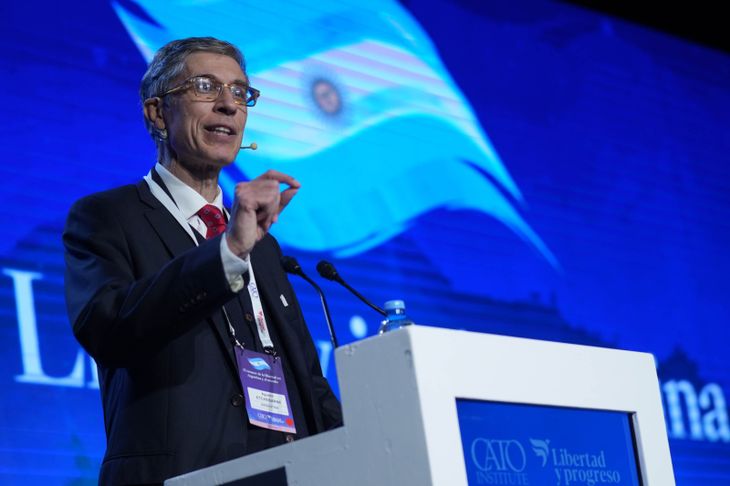When drawing the road map, the director of Freedom and Progress underlines a key factor to reduce distortions in the economy: fiscal balance. To hold the surplus, he argues that “Public spending has to continue going down” and that the number of state employees should be reduced from four to two million throughout the country.
Within that framework, it expresses its desire for an alliance between Freedom advances and the PRO that allows to reach an electoral triumph in 2027 with a floor of 60% of the votes.
Etchebarne33.png
Agustín Etchebarne, in dialogue with scope.
Journalist: The central theme of the last days was the disarmament of the Lefis and its impact on interest rates. How do you read this dynamic? Was there a timing error, of implementation, or was it a success that found no response from the financial system?
Agustín Etchebarne: I have a longer term look. The government, at the time, had two options: go for dollarization or follow the Luis Caputo program and its team. I was in the group that promoted dollarization, but, seeing it a year and a half later, the result of the current plan has been very successful. We had a very strong reduction in inflation – from 211% to a projection of 25% or 26% annual -, an important sanitation of the Central Bank, and an extraordinary decrease in public spending of 25% in the first month of management. This adjustment allowed the fiscal surplus and reduce the quasifiscal deficit. In addition, poverty fell from 50% to levels close to 31%, according to estimates of the UCA and the Torcuato Di Tella University.
Q.: So the elimination of the Lefi did not generate a financial response?
AE: What we saw are implementation details. We are disarming a very complex scheme – the stock – with thousands of regulations. The financial system is normalized: the exchange gap was reduced to zero or even negative in some days. There is intervention, of course, but the official exchange rate today floats in a band. Volatility is part of the process, because no official can anticipate the decisions of all economic actors. The important thing is that the anchor is the fiscal surplus.
Q.: If during the campaign the program was dollarization, what happened? Why did it end up opting for another scheme?
AE: There was a meeting where Emilio Ocampo was, which proposed dollarization, and Caputo, with another approach. Javier Milei wanted us to agree, but that was not possible. The Caputo path was opted, and I confess that I was wrong: I thought that the initial fall in “V” was going to deteriorate the presidential image. The surprising thing was social support, even in the face of hard measures. That speaks very well of Argentines.
Q.: What does the Caputo program contribute that the proposal for dollarization does not? Is it more pragmatic, less risky?
AE: Both were complex programs. Today, with Monday’s diary, it is easy to say that this was better, but it is true that the result is very successful. The economic freedoms of Argentina improved about 60 positions in the Heritage Foundation economic freedom index. We were among the most repressed countries in the world. Today we are in the middle of the table. There is a lot, but the address is correct. The structural reforms, the DNU 70, the cut of ministries, the deregulation that Sturzenegger carries out … Everything points to the model we proposed from freedom and progress.
Q.: What is missing to consolidate that course?
AE: The labor reform is key, because half of the economy is in black and that prevents companies from growing, accessing credit or going to the stock market. The SME path was looked at a large company. In addition, informality implies more volatility. In this crisis, informal wages fell strongly, although they are now recovering.
IMG-20250725-WA0084

Q.: What do you mention also explain the low investment?
AE: Clear. We live in a country with natural resources such as the Andes mountain range, which we share with Chile, only that the neighboring country exports US $ 55,000 million in minerals; We barely US $ 4,000 or a little more. Rigi can change that. It is a regime that, although it is not a pure liberal scheme, allows you to anticipate tax benefits and attract investments.
Q.: The Government argues that the fiscal surplus is unwavering, but Congress approved expenditures that meet the demands of various sectors. Is it possible to combine both interests?
AE: Public spending has to continue going down. The provinces and municipalities have not adjusted. In many cases, the provincial state is larger than the National. There are municipalities with deliberative advice that function as feudos, where clientelism is maintained with unnecessary public employment. In total, We have 4 million public employees. You have to reduce at least 2 million. When we had 2 million, there was better health, education and infrastructure: the keyword to raise salaries is productivity.
Q.: How long should this employee cut?
AE: I do not put a deadline, but you have to do it. The State must focus on a few things, but well done, and the rest must be left to the private sector. The railroads, for example, were excellent when they were deprived, but were nationalized in 1949 and the decline began.
Q.: Does the idea of a “dual Argentina” coincide, with sectors that access cheap imports and others that do not buy food at the end of the month?
AE: I don’t see it that way. The data indicates that the feed and the AUH card went up and poverty went down. What exists is a difference between working in the private or public sector. State salaries grew less and that was deliberate. It sought to encourage private employment. Many young people who go from the country today are reconsidering staying. With higher dollars salaries, they can think of life projects here again.
Q.: What will happen to the dollar in the second semester?
AE: Pre -election volatility exists and can continue, but the fiscal surplus is a powerful anchor. The consolidated debt fell $ 25,000 million compared to November 2023. In addition, the dollar depreciates globally. I do not encourage the short term, but I see stability forward. This year it would close with 26% –27% inflation; Next year it could be 8%. With these rates, I bet on weight, no doubt. Taking debt in pesos today, with very high rates, is not a good idea. But 7%dollars debt, as some companies are getting, it is.
Q.: And what impact have high rates on activity?
AE: The high rates are bad. But they are going down, they fell to 30%. They went up a bit for the disarmament of the Lefi, but that is conjunctural. If within two years the rates are still equal, the plan will have failed. But I don’t believe it. We go to inflation in a low digit and normal rates. Israel and Japan took seven years to achieve it. Here it is being achieved in much less, in a year and a half.
Q.: Sturzenegger said in the rural that “there is no country risk, there is a kuka risk” and you claim to agree, even if they hold internal ones within the party that take away competitiveness. Because?
AE: Politics is an important issue that had not come out in the interview. Peronism has appointed almost all judges. It has trade union, territorial and in many provinces. When he won the step in 2019, the Stock Exchange fell 37% in one day. Not a war achieves that. Because? Because its logic is to fight capital, and in that sense it is more destructive than a war. SMEs and savers suffer; The friends of power benefit. It is a corporatist model, almost fascist. We want a free country, with private initiative.
Q.: Do you think the ruling can win the 2027 elections?
AE: If the economy continues to improve, yes. The ideal would be a solid agreement between freedom progresses and the PRO, with a clear campaign. You have to avoid internal fights. I would bet to build a majority of 60%. Most Argentines want a normal country, with less taxes and more freedom. Argentina deserves it.
Source: Ambito




